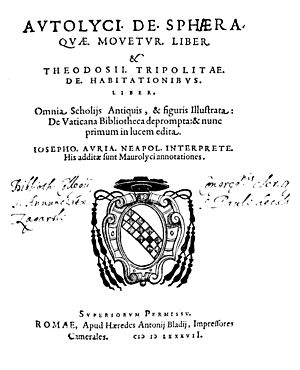Autolycus of Pitane facts for kids
Autolycus of Pitane was an important Greek astronomer, mathematician, and geographer. He lived a long time ago, around 360 to 290 BC. He was so famous that a lunar crater on the Moon was named after him! It's called Autolycus.
Contents
Who Was Autolycus?
Autolycus was born in a town called Pitane. This town was in an area of ancient Greece known as Aeolis, in what is now Turkey. We don't know much about his personal life. However, we know he lived at the same time as the famous thinker Aristotle.
His main work was likely done in Athens between 335 and 300 BC. Another famous mathematician, Euclid, even mentioned some of Autolycus's ideas. Autolycus also taught a student named Arcesilaus.
His Important Books
Autolycus wrote two main books that we still have today. One is about spheres, called On the Moving Sphere. The other is about how celestial bodies (like stars and planets) rise and set. It's called On Risings and Settings.
A scholar named Maurolycus translated Autolycus's works in the 1500s. This helped keep his ideas alive for future generations.
On the Moving Sphere
This book is very special because it's believed to be the oldest complete math book from ancient Greece that we still have! Many older Greek math works only exist as summaries or notes from other writers.
On the Moving Sphere survived because it was part of a popular collection. This collection was known as "Little Astronomy." It was translated into Arabic in the 800s. Later, during the Crusades in the 1100s, it came back to Europe. Then it was translated into Latin.
In this book, Autolycus looked at how spheres move and what they are like. The book has basic ideas about spheres. These ideas were important for astronomers of his time. The book shows how Greek geometry was taught. It had clear statements, pictures, and proofs for each idea.
On Risings and Settings
Autolycus also studied how stars and other objects in the sky appear and disappear. He wrote about this in his book On Risings and Settings. He said that "any star which rises and sets always rises and sets at the same point in the horizon."
He used the ideas of another astronomer named Eudoxus. Autolycus strongly supported Eudoxus's idea of homocentric spheres. This was a theory about how the planets and stars moved around the Earth.
See also
 In Spanish: Autólico de Pitane para niños
In Spanish: Autólico de Pitane para niños


